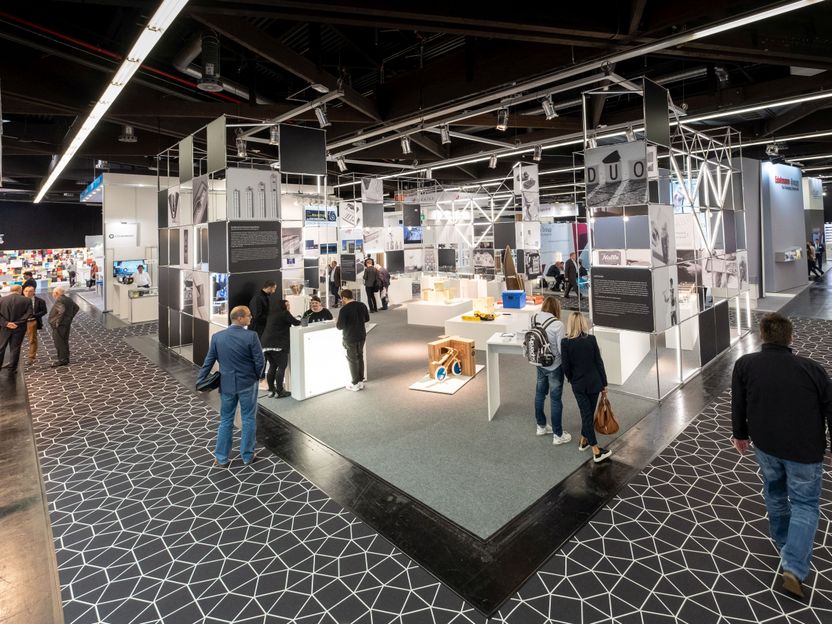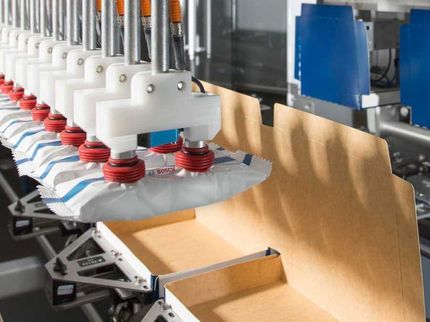The premium packaging of the future
Stylish packaging design and innovative materials appeal to younger generations

NürnbergMesse
Even in the case of products for daily use, first impressions matter. And at the point of sale, the first impression is generally the packaging, because it’s the first thing that the customer notices. In this context, design is especially important, as the packaging has to appeal to the customer to trigger the impulse to buy it. According to a survey conducted by Statista, 69 percent of German companies are convinced that packaging design plays a major role in brand management and communication with customers. At FachPack 2018, packaging design and innovative materials were put under the spotlight at the special show Premium Packaging, which was created by bayern design on behalf of NürnbergMesse. The around 40 exhibits from all over the world were impressive evidence of how packaging design can help achieve a successful brand image. At the show, which was divided into the three categories EMPOWER, SUSTAIN and CONNECT, visitors were able to admire a selection of award-winning packaging designs from the premium segment that bring trends, technologies and materials to life.
Packaging as added value
The EMPOWER category showcased products where the packaging doesn’t just perform a protective and transport function but is at the same time a part of the product for which the customer can find an additional use. For example, Anne Bansen, student of industrial design at HTW Berlin, developed a clever alternative to the conventional best-before date with her Tast(e) Food packaging, winning the German Packaging Award 2017 in the “Young Talent” category. The packaging “communicates” with the consumer via a sealing foil that changes its structure and indicates when the contents are inedible. As soon as biochemical changes occur in the protected atmosphere of the packaged food, this is indicated on the packaging by means of visual and tactile information.
Packaging that is sustainable
Sustainability, environmental compatibility and avoiding plastic are the hot topics in packaging design. The SUSTAIN category presented pioneers in this area. One of the many outstanding examples was a packaging solution from Finland using a packaging material innovation made of FSC-certified timber and natural binders that is completely biodegradable. It won the Sustainable Packaging Award 2017. The material has all the benefits of plastic and is also superior to other sustainable alternatives in terms of price, barrier effects and speed of bio-degradation.
Outstanding storytelling, successful brand image
The third category, CONNECT, acknowledged premium packaging that succeeded in expressing the story and the spirit of the brand in a special way and playfully encouraging consumers to interact with it. One such example is the packaging designed for the Oberhofer winery’s very special wine bottles for the very limited release 2016 vintage of 400 year-old vines from “Rhodter Rosengarten”, the oldest vineyard in the world. The history of the wine is very cleverly visualised through the overall look of the packaging: the printed pattern recreating the woody structure of the vines, the gnarly, vineshaped cut-out on the front, the four layers – one for each century – that are fanned out to reveal the bottle, and last but not least, the solid base in rustic oak. It’s a complete work of art that perfectly conveys the story of the brand and won the Red Dot Award in 2018.
This and other examples at the special show Premium Packaging were evidence that good packaging design is also always aligned to the respective needs and preferences of the target group, e.g. added benefit, environmental compatibility or storytelling. The expectations imposed on packaging also depend on the age of the consumers it is designed to appeal to. This was also one of the topics discussed at the PackBox Forum at FachPack 2018.
Generation Y and Z: discerning consumers
In her presentation, Nina Saller, designer and founder of Munich-based XbeyondS, said that younger target groups in particular, like Generation Y and Z, are very discerning about packaging. Their value systems are very different from those of the older generations. The consumer behaviour of Generation Y, also known as “Millennials”, i.e. those born between 1980 and the late 1990s, and the subsequent Generation Z (born 1995 to 2010) is characterised by enjoyment, individuality and a social conscience. Saller explained that packaging manufacturers are responding to these preferences, requirements and beliefs with packaging that is manufactured using few resources, gives the consumer added value, looks classy and can be re-used, composted or recycled.
Inspiring, smart and sustainable packaging in demand
With regard to packaging trends, the speaker provided examples that can be described using the umbrella terms “identify – inspire”, “enrich – smart” and “preserve – sustainable”. These include packaging as an “identity-defining accessory”, that generates elements of surprise, offers added value and serves as a communication medium. For example, a cosmetics manufacturer has produced a transparent paper bottle made from 100 % PCR paper. Once the contents of the bottle have been used, the consumer can break up the packaging to separate the materials for recycling. As an incentive the packaging contains a packet of plant seeds. The “enrich – smart” category includes packaging that allows “interaction” with the consumer, creates “wow effects” and offers the consumer a benefit. For example, packaging elements can be printed with special ecologically sound inks that are only visible under UV light. These inks can be used for brand protection and for advertising messages. Packaging in the category “preserve – sustainable” is characterised by the following properties: consists of sustainable resources or waste material, easy to process, doesn’t look “green” and is biodegradable. The University of Ghent, for example, developed a sustainable packaging from coriander oil and chitosan, a biopolymer derived from the shells of crustaceans, to extend the shelf life of food products and cosmetics. The material has natural protection against fungi and bacteria, is as strong as aluminium but weighs only half as much, and is completely compostable.
At FachPack 2019, the highly topical issue of “environmentally compatible packaging” will also be reflected at many exhibitor stands, at the special show in Hall 8 and in the accompanying supporting programme. Smart solutions will be presented that serve both the environment and consumers while also keeping the entire product cycle in focus.





























































